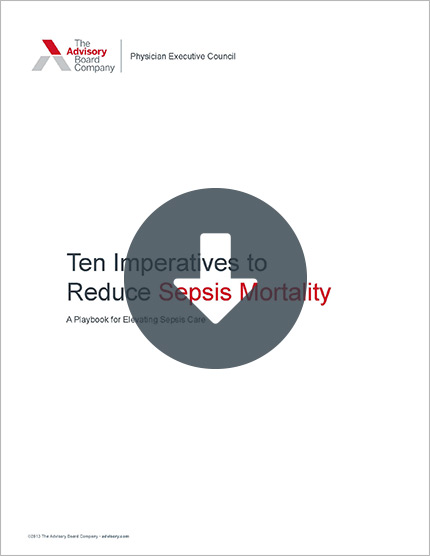Auto logout in seconds.
Continue LogoutRead Advisory Board's take on this story.
About half of U.S. hospitals do not follow CMS' recommended sepsis and septic shock treatment guidelines, according to Hospital Compare data released Wednesday.
Wednesday marked the first time CMS publicly released such data since it introduced the Severe Sepsis and Septic Shock Early Management Bundle measure about three years ago.
Background
There has been some debate over the specific definition of sepsis, but generally, it refers to the body's inflammatory response to an infection that leads to organ systems shutting down and, in some cases, mental confusion. Sepsis can be fatal, and prompt treatment can be the difference between life and death. Signs of sepsis include extreme pain or general discomfort, sleepiness, shortness of breath, and a shiver or a fever.
CMS in July 2015 adopted the Severe Sepsis and Septic Shock Early Management Bundle measure to show the share of patients with severe sepsis or septic shock for which a hospital provided appropriate care. CMS designed the measure to improve the identification and treatment of sepsis.
The measure focuses on a hospital's process for effectively and quickly treating sepsis, which means does not directly reflect the outcomes of patients with sepsis. The measure does not examine the rates of sepsis or sepsis deaths.
The measure evaluates whether hospitals follow several time-sensitive guidelines for treating sepsis using data on a pool of patients experiencing organ failure and an algorithm to determine compliance. When a patient has severe sepsis, hospitals under the guidelines are supposed to measure the patient's serum lactate levels, collect blood cultures, and provide antibiotics within three hours of diagnosis. When a patient has septic shock, hospitals under the guidelines are supposed to follow that protocol and take several other steps within six hours.
The data released Wednesday are based on how 3,005 hospitals treated adults with sepsis during the first nine months of 2017, Modern Healthcare reports.
Findings
The Hospital Compare data showed that, nationally, 49% of hospitals on average followed sepsis treatment guidelines in the first nine months of 2017. Rates for following the treatment guidelines ranged throughout the United States, as well as within health care systems. Rhode Island and Delaware had some of the lowest compliance rates, according to Modern Healthcare.
Experts raise concerns over the sepsis care data
Several experts have said it's important not to take the data out of its context as a measure of whether hospitals are following a specific process.
David Mayer, vice president of quality and safety at MedStar Health and board member of the Patient Safety Movement, said the compliance data does not take into account clinical judgement. Mayer said clinicians can decide whether moving forward with a preventive treatment is appropriate for a patient, noting that just because an electronic health record (EHR) alerts a clinician that a patient might have signs of sepsis, it does not mean the patient has sepsis. "We still want good clinical judgment, and we don't want to be over-treating those who we feel pretty confidently don't have sepsis," Mayer said.
Further, documentation errors might skew compliance results, Modern Healthcare reports. Clinicians must manually enter data on the measure within three or six hours of the treatment, but some physicians provide the documentation too late, which means staff later have to report that the measure had not been used. He said, "Many times when we go back in the charts we are compliant with many of these bundles, be it sepsis or ventilator-associated pneumonia, but someone didn't document it correctly or they documented later in the day."
According to Mayer, the measure on sepsis care provides less information than a measure on sepsis mortality, which he said offers more insight on clinical care and improvement opportunities. "What CMS has done with sepsis has elevated everyone's game and made us all aware of the importance of compliance but I take these numbers with a grain of salt," he said.
James Shamiyeh, a pulmonary and critical-care physician and medical director of UT Medical Center's Heart Lung Vascular Institute, said, "While 45% to 50% compliance, to the lay person, may seem low, that range is not a bad place to have landed, relative to the complexity of the measure." However, he added, "There's still more work to do. This is not an easy thing to tackle." According to Shamiyeh, sepsis-related complications, length of stay, and mortality at UT Medical Center decreased since the medical center overhauled its sepsis program and developed specific procedures for quickly treating suspected cases of sepsis in 2015-2016. Shamiyeh said hospitals receive sepsis cases of varying complexity, and standard guidelines might not always provide the best treatment (Castellucci, Modern Healthcare, 7/27; Knowles, Becker's Clinical Leadership & Infection Control, 7/27; Nelson [1], Knoxville News Sentinel, 7/27; Nelson [2], Knoxville News Sentinel, 7/27).
Advisory Board's take

By Veena Lanka, MD, Senior Director
At first glance, the 49% SEP-1 compliance figure appears shocking and absolutely unacceptable for a developed nation such as the United States. The report may rightfully spark outrage and fear among readers, especially those who are currently in a hospital, have close ones in a hospital, or are suffering from chronic conditions that could bring them into hospitals.
However despite the shocking headline, this performance report is not cause for alarm for patients or providers. When you begin to deconstruct the 49% result, it quickly becomes clear that the sepsis definitions used by CMS don't quite line up with the latest evidence. Here are 4 reasons why you shouldn't panic:
- The measured sepsis definitions do not sync up with clinical definitions. The sepsis definitions CMS uses differ in small but significant ways from the way physicians currently identify, diagnose, and manage sepsis. Further complicating the matter is that unlike most clinical diagnoses, there is no universal consensus among providers on what exactly constitutes the best definition of sepsis, severe sepsis, and septic shock, since the condition progresses differently in all patients. This makes it nearly impossible and, more importantly, clinically inappropriate to respond the same way to all sepsis patients, and makes it difficult to make the clinical reality to line up with retrospective ICD-10-based analyses.
- SEP-1 is an 'all or nothing' measure. In order to be considered SEP-1 compliant by CMS' standards, a hospital has to be compliant on every single component of the protocol. This translates to approximately 141 tasks and 3 hours of documentation that need to be performed by clinicians for each patient in a three to six hour window, according to a systematic review by Dr. Dominique Pepper. In addition to being unrealistic, some of the steps, such as central line insertion, are quite invasive and often clinically not necessary.
- SEP-1 measures are not necessarily backed by clinical trials. Patients worried about a hospital's performance on sepsis care would be better served to look at a hospital's actual sepsis-related mortality rates, than they would be looking at their SEP-1 compliance rates, as some SEP-1 measures have not been clinically proven to consistently lead to lower mortality.
- Sepsis response in each individual is unpredictable and highly variable. Unlike many diagnosis where the treatment path and expected patient response tend to be more clear cut, when it comes to sepsis, the right inputs do not always translate to the expected outputs. The human immune response is a difficult thing to predict, quantify, and redirect. This does not mean we stop trying to put protocols in place for sepsis, it just means we ought to have a buffer for the performance metrics to account for the high rate of clinically warranted exceptions in sepsis.
Therefore, the SEP-1 measure as it exists today is not a definitive indicator of a hospital's clinical outcomes for sepsis. Until the limitations are iterated upon by CMS, providers should:
- Continue to provide timely and constructive criticism to CMS on the definitions and treatment recommendations;
- Continue conducting and publishing clinical trials to identify most effective diagnostic tools, morbidity indicators, and treatment modalities;
- Analyze CMS released data to understand where exactly the gaps in care lie for their hospital and better differentiate principled exceptions and documentation issues from true protocol compliance issues;
- Keep up the efforts to train, educate, and bring together multidisciplinary teams on better hand-offs, consistent documentation, standard response protocols and accurate communication; and
- Continue to improve documentation and coding.
For a more detailed analysis of this news and information about what providers can do to improve their sepsis quality keep an eye out for my upcoming blog post on the topic.
In the meantime, make sure you read our research report on 10 imperatives to reduce sepsis mortality. Not a Physician Executive Council member? View our infographic on the how to improve sepsis outcomes.
Don't miss out on the latest Advisory Board insights
Create your free account to access 1 resource, including the latest research and webinars.
Want access without creating an account?
You have 1 free members-only resource remaining this month.
1 free members-only resources remaining
1 free members-only resources remaining
You've reached your limit of free insights
Become a member to access all of Advisory Board's resources, events, and experts
Never miss out on the latest innovative health care content tailored to you.
Benefits include:
You've reached your limit of free insights
Become a member to access all of Advisory Board's resources, events, and experts
Never miss out on the latest innovative health care content tailored to you.
Benefits include:
This content is available through your Curated Research partnership with Advisory Board. Click on ‘view this resource’ to read the full piece
Email ask@advisory.com to learn more
Click on ‘Become a Member’ to learn about the benefits of a Full-Access partnership with Advisory Board
Never miss out on the latest innovative health care content tailored to you.
Benefits Include:
This is for members only. Learn more.
Click on ‘Become a Member’ to learn about the benefits of a Full-Access partnership with Advisory Board
Never miss out on the latest innovative health care content tailored to you.

